Here's a summary of this post:
Product copywriting can be hard.
You need to find the right words to entice customers without forgetting about search engines. Users should always come first, but you need to understand how search engines interpret content.
Everything must also be tightly packed into just the right length whilst ensuring the copy flows and reads well.
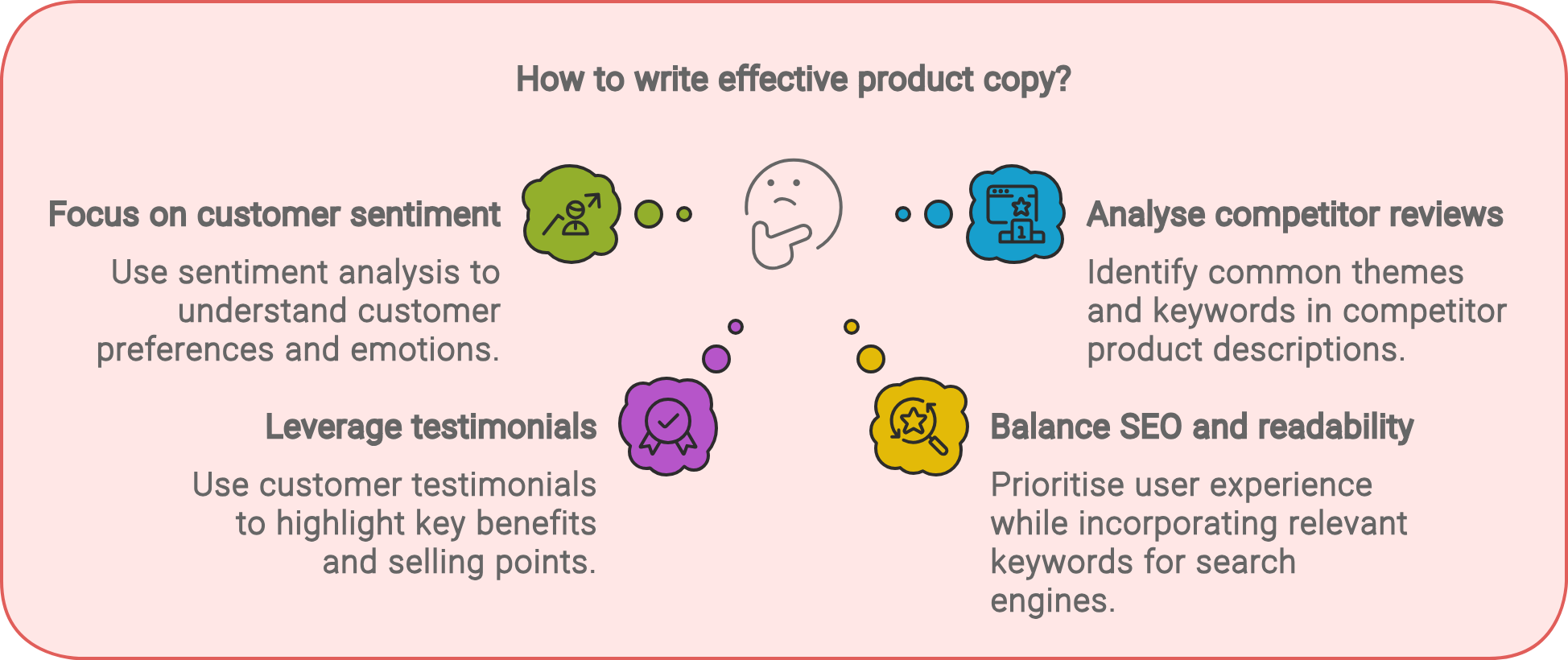
Many marketing and copywriting experts recommend writing just around 300-600 words of product copy. That's not a lot, so you need to make every word count.
In this post, we'll discuss how to use competitor reviews, sentiment analysis, and testimonials to discover the best keywords and angles for your product descriptions.
What is Competitor Analysis?
In a marketing sense, competitor analysis is the process of evaluating your top competitors and utilising their strategies to your advantage.
"Top" is the important word here.
Your top competitors will likely have invested time and money into their marketing; they’re usually the ones sitting at the top of the tree. If you undertake correct competitor analysis techniques that match your specific objectives, you can learn from their investment.
What are the different ways to use competitor analysis?
Competitor analysis can be used in multiple areas of marketing:
- Keyword research. Find and steal your competitor's top-performing keywords.
- Social media marketing. Track down social media content strategies that you know will generate engagement.
- Content research. Borrow popular content ideas and topics from your competitors.
- Market gap analysis. Analyse multiple competitors and their customer feedback to identify underserved markets.
- Email marketing. Subscribe to your competitor's email list to obtain ideas for newsletters, automated emails, and email optimisation.

When it comes to product copywriting, you can take competitor analysis a little further.
Instead of just borrowing keywords and writing style ideas, you can look at your competitor's reviews, comments, and other forms of customer feedback. In doing so, you'll uncover customer pain points and suggestions that can enrich your product copywriting strategy.
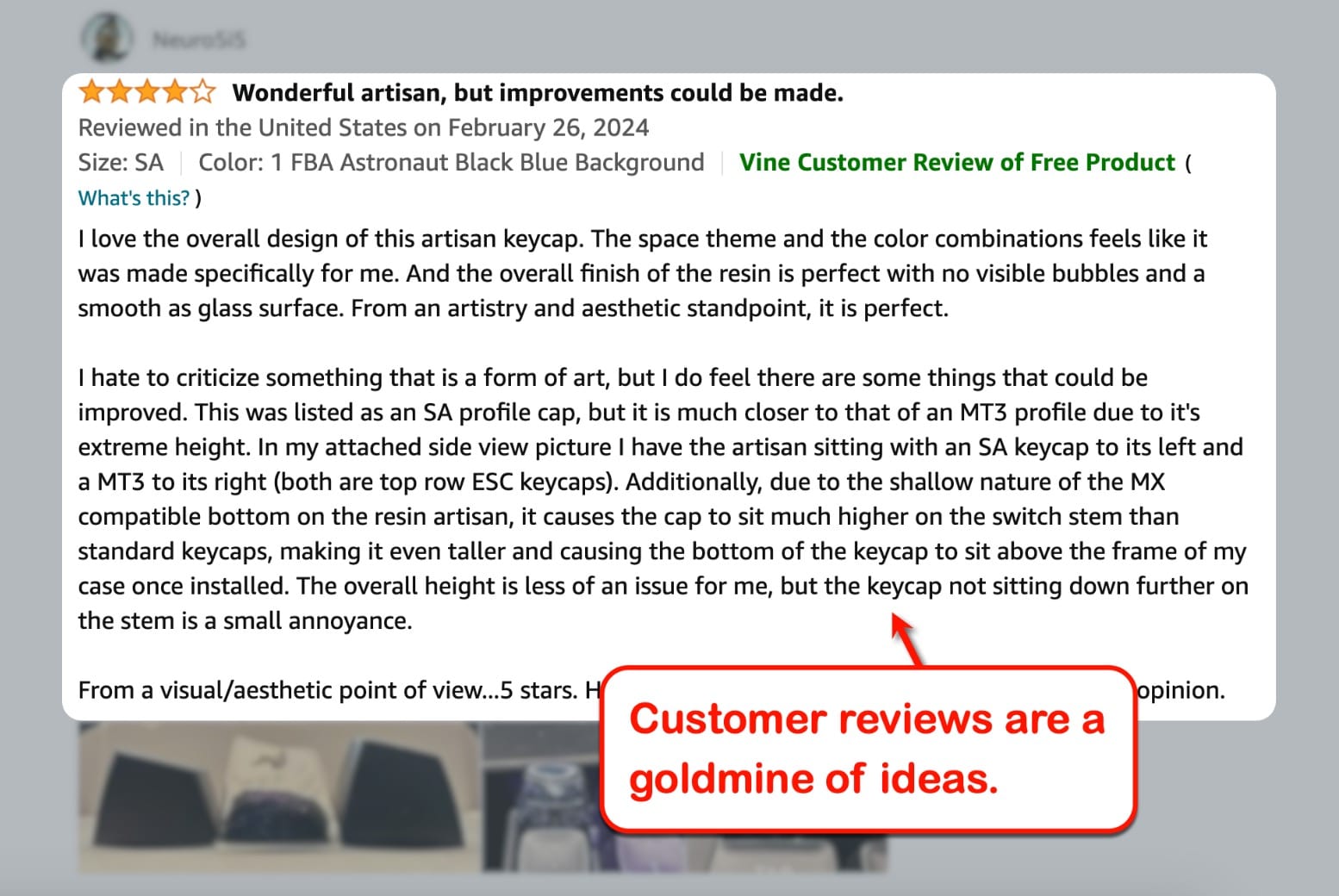
At the same time, you'll discover the positive things that customers love about a competitor's product. These are excellent talking points to include in your product descriptions if you want to captivate potential customers.
How to use competitor analysis for product copywriting
Now that you understand how competitor analysis can affect product copywriting, it's time to take some action.
Follow the steps below to conduct competitor analysis for product copywriting effectively:
Step 1: Specify what you're looking for
When conducting competitor analysis, you need to define the information you're looking for clearly.
This will help you determine the best tools and approach to use in your analysis.
For example, service providers may look at the pricing, performance, UI design, and known technical issues of their competitor's products. Bloggers, on the other hand, need to look at their competitors' keywords, topics, and promotion channels.
Right now, you're looking to create better product descriptions by analysing competitor reviews. That means your analysis should centre around 4 areas:
- Customer complaints
- Praises
- Improvements and suggestions
- Keywords
Next, build a simple spreadsheet that lists and organises these details as you scrape them from customer reviews. This will serve as your sentiment analysis spreadsheet, which is incredibly useful if you work with a content team.
Any spreadsheet tool like Google Sheets would be perfect for this job.
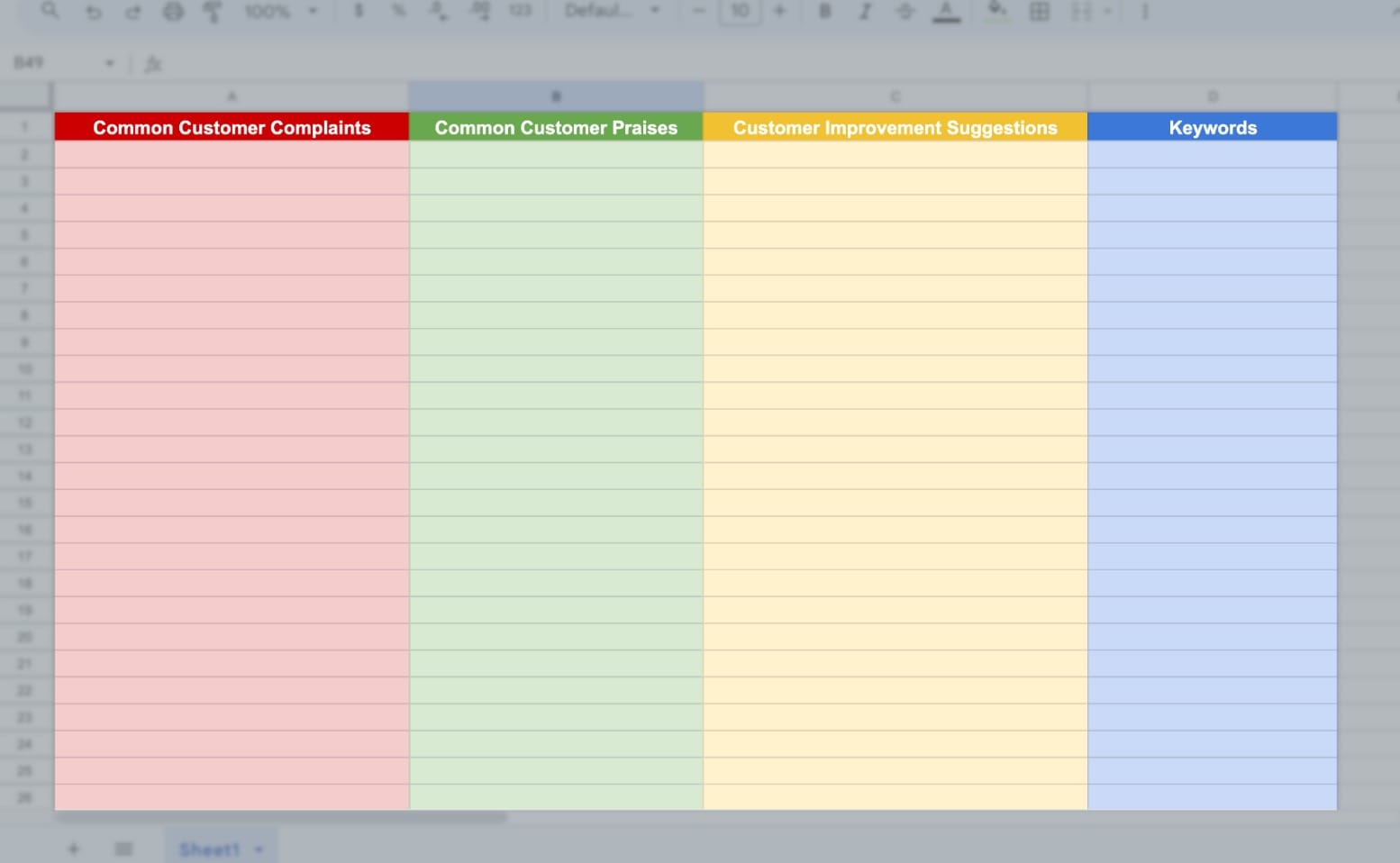
While you're at it, set its general access permissions to 'Anyone with the link' and invite your copywriting team to view the file. You'll find the options you need by clicking 'Share' in the upper-right corner.
You'll fill the details out later as you analyse competitor reviews.
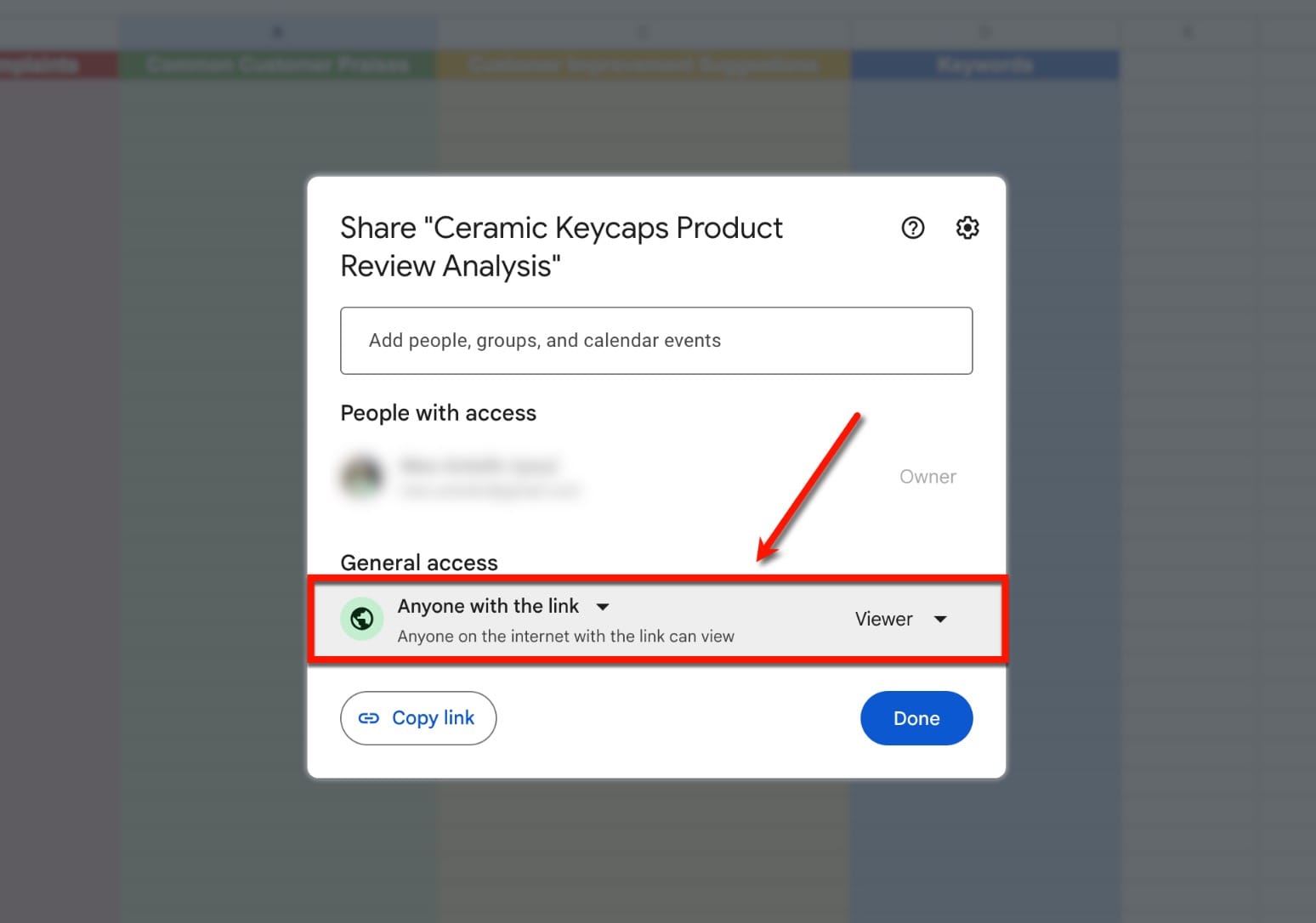
Step 2: Identify your top competitors (if you haven't already)
Sometimes, looking for your biggest competitors isn't as simple as using the ones that you're aware of. Your search engine or social media competitors are often different from your traditional competitors.
Maybe you've never thought about analysing competitors in this much detail before. Or, you could be exploring new product ideas and would like to see who you'll square up against.
Whatever the reason, tools like Semrush offer surefire ways of identifying competitors.
The most straightforward method is to use the Market Explorer feature.
Just head to 'Market Explorer' under "Trends" and select 'Find Competitors.' From there, enter your website URL and click 'Search.'
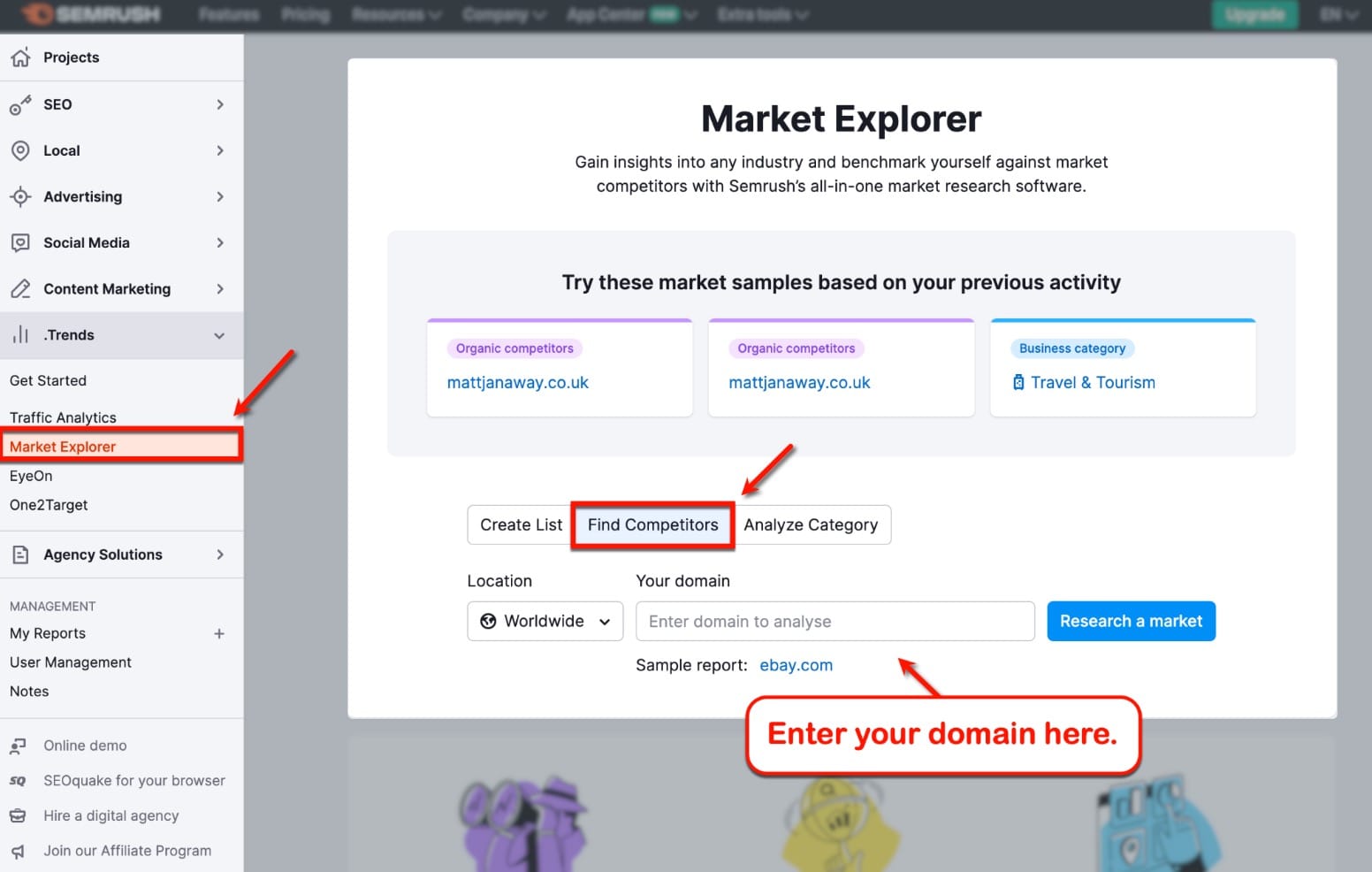
Your top competitors and the key players in your market should be visible in the "Market Summary" section. You'll also find more competitors if you scroll down to the "Domain vs Market Dynamics" list.
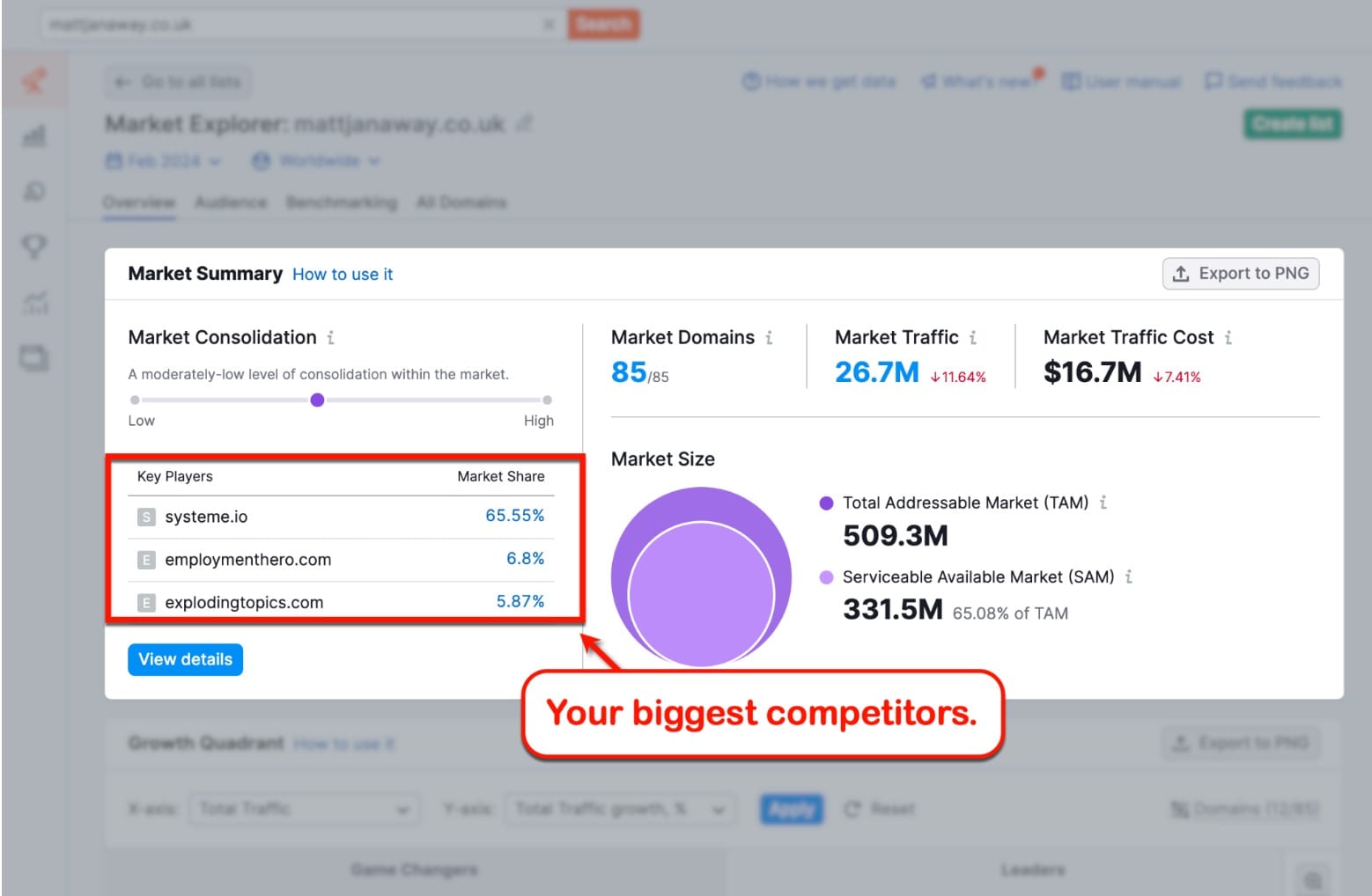
Another way to find competitors with Semrush is to use the Organic Research tool.
To use it, go to 'Organic Research' from the main menu, enter your domain URL, pick your target country, and click 'Search.'
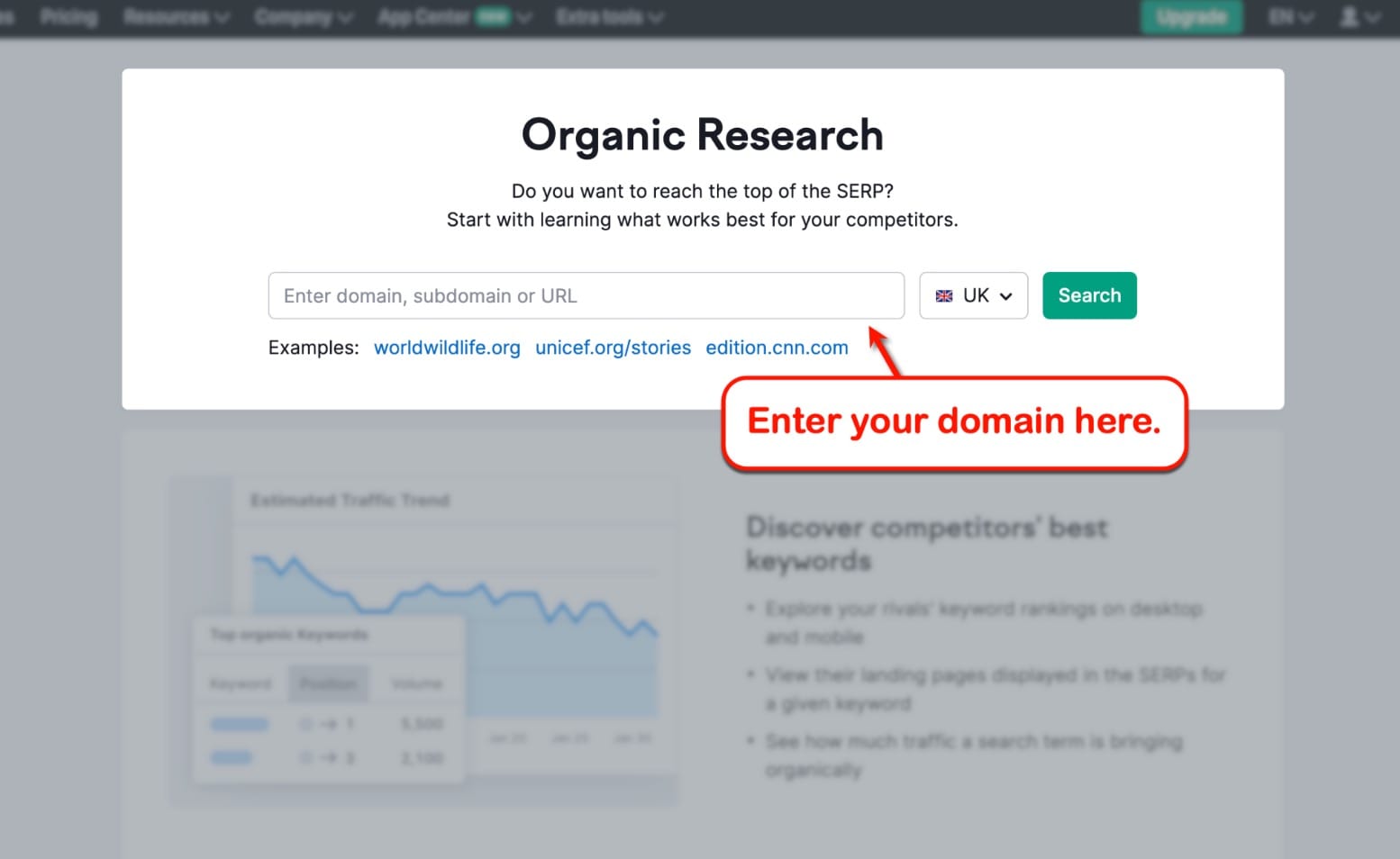
Give Semrush a few seconds to generate your report.
When done, simply click on the 'Competitors' tab to view your website's top organic competitors.
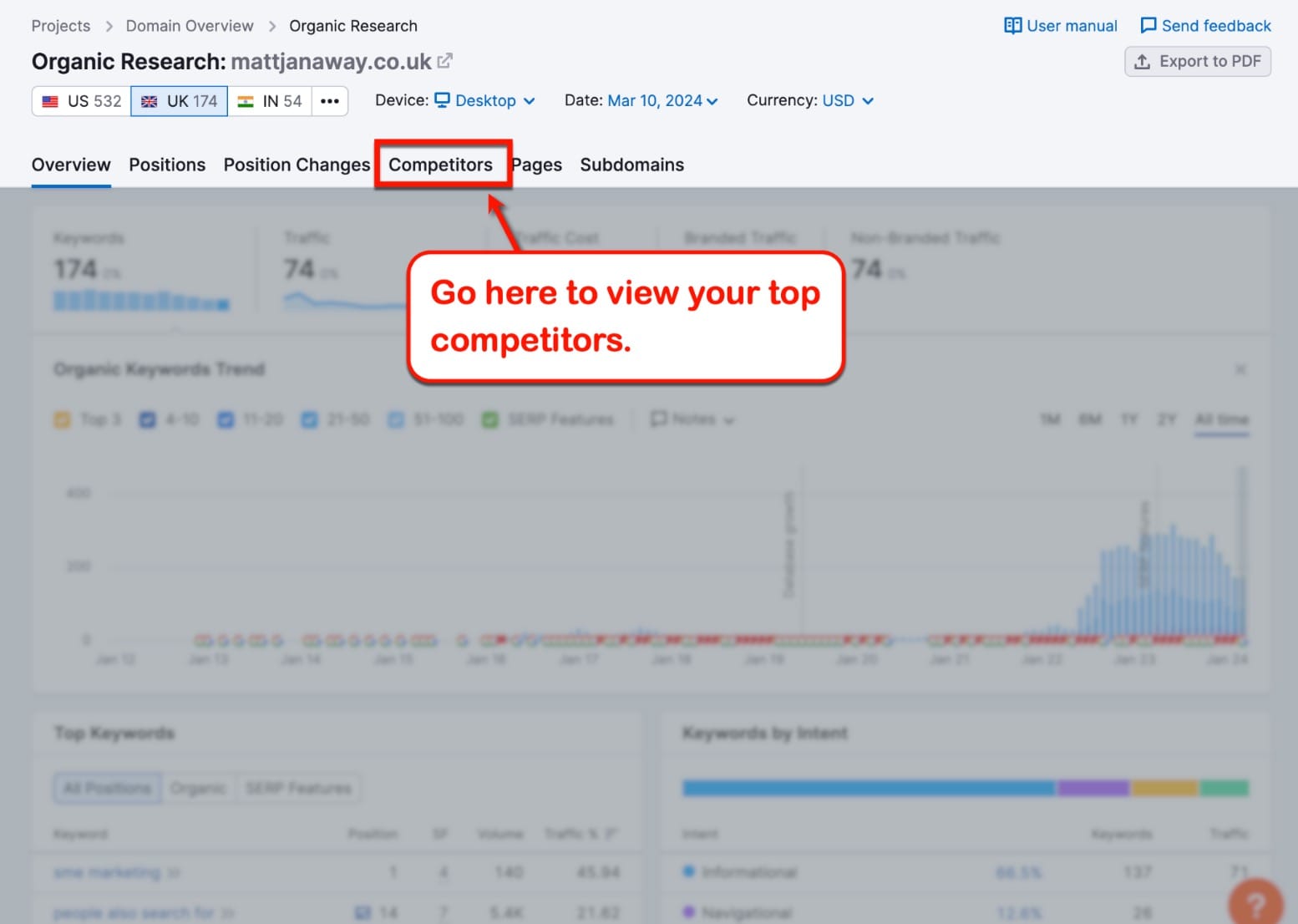
Ideally, you should be aware of every single business competing for your target audience's attention. But for now, focus on businesses that sell the most products in your space.
Keep in mind that your organic competitors are businesses that target the keywords relevant to your industry. It would be wise to conduct a deeper analysis of how they optimise their content for keywords — it should help greatly with your product descriptions in the long run.
Again, Semrush is great for this objective. They also offer a free trial with all core features unlocked (but with daily quotas).
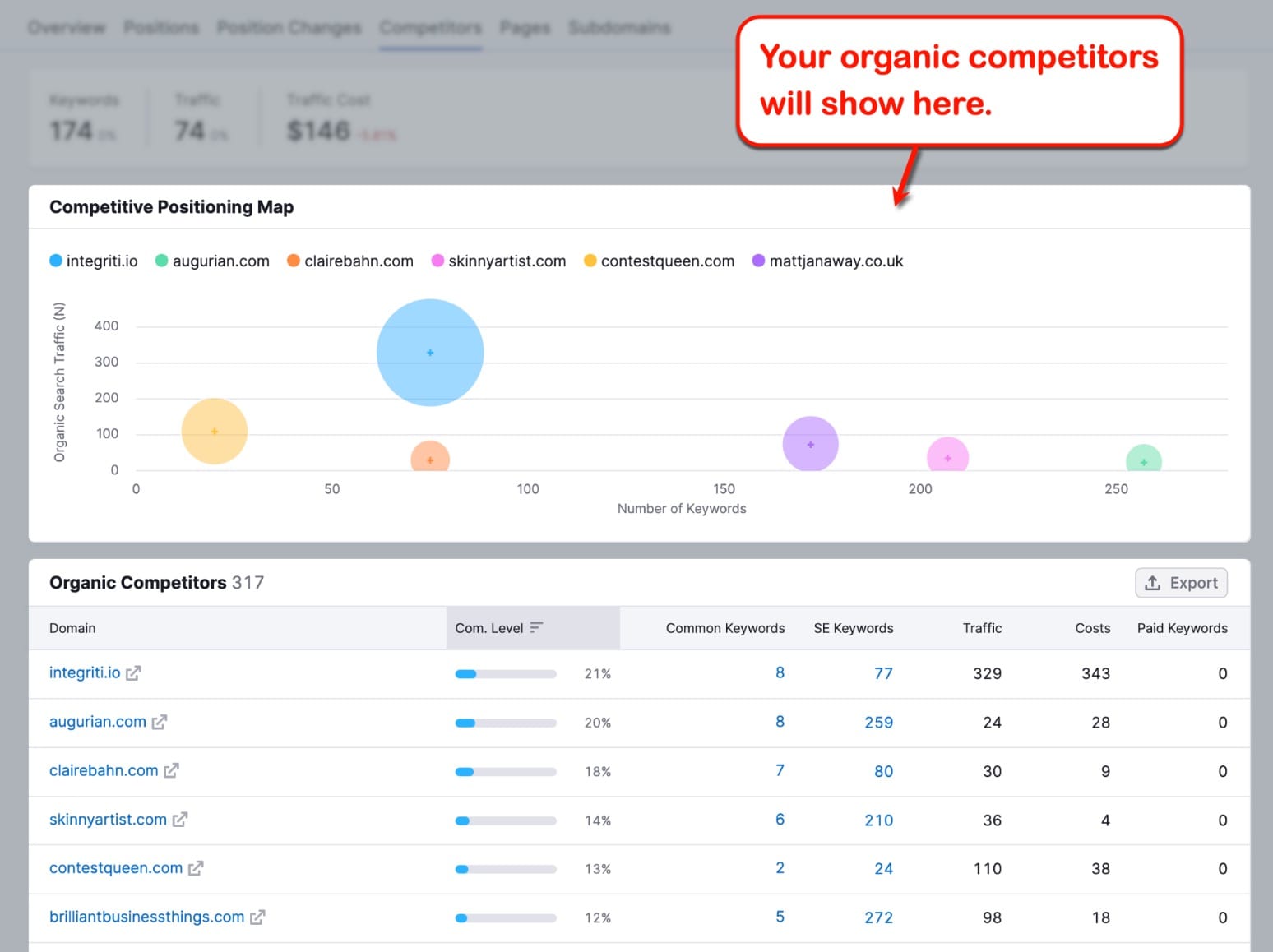
After finding your top competitors, you can start looking for both positive and negative customer reviews about their products.
Step 3: Look for five-star reviews
The next step in the process is to look for positive reviews to identify sought-after qualities in your products.
On the internet, customers leave reviews on various websites and platforms. It can be your competitor's own website, social media page, ecommerce marketplace, or any third-party review platform.
Let's say your competitor is on Amazon.
You can find customer reviews and ratings directly on your competitor's product page. Scroll to the bottom or click the 'ratings' link below the product's name.
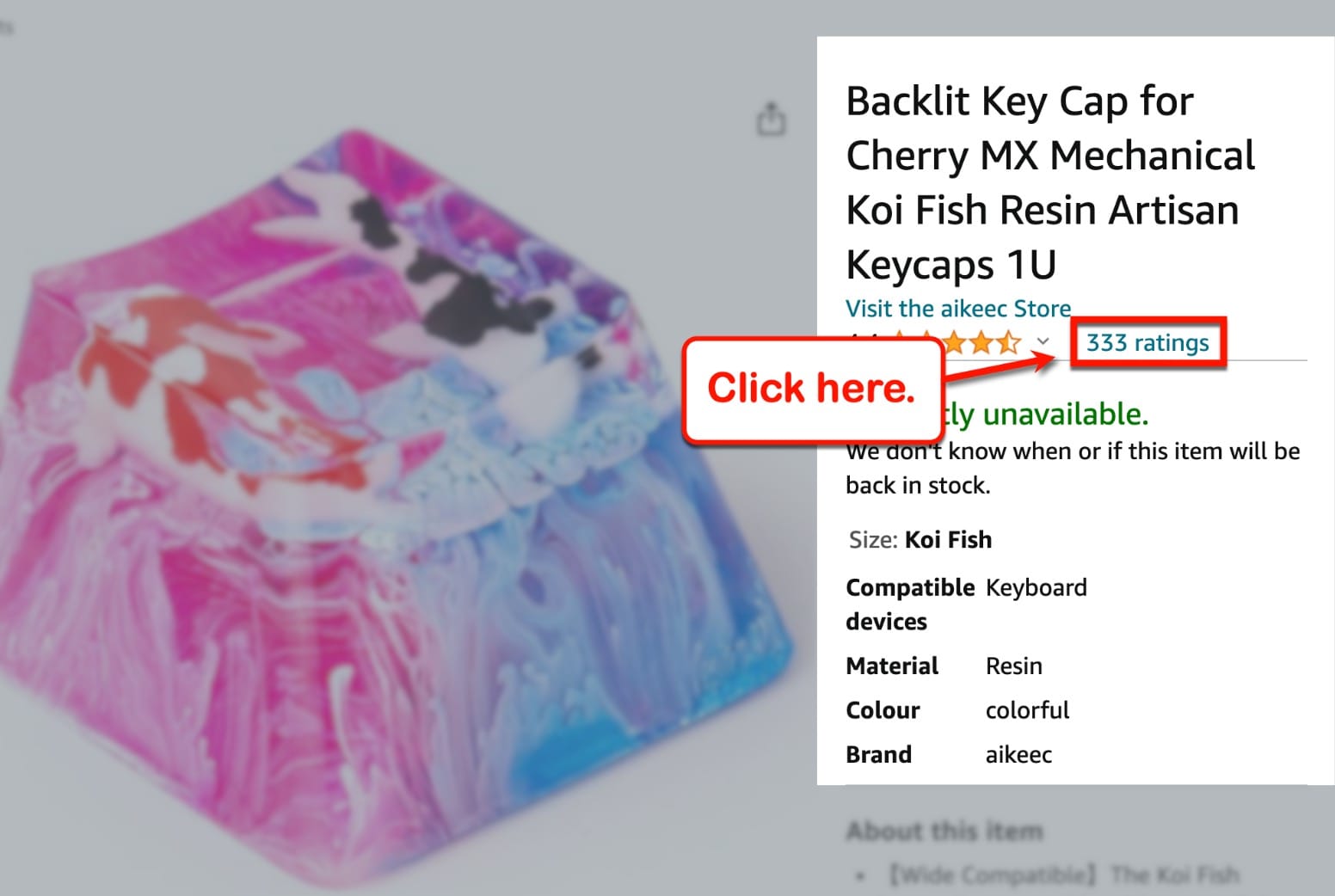
Right above the reviews section, select '5 star only' in the drop-down menu under "Filter By." This will automatically refresh the list only to contain positive reviews.
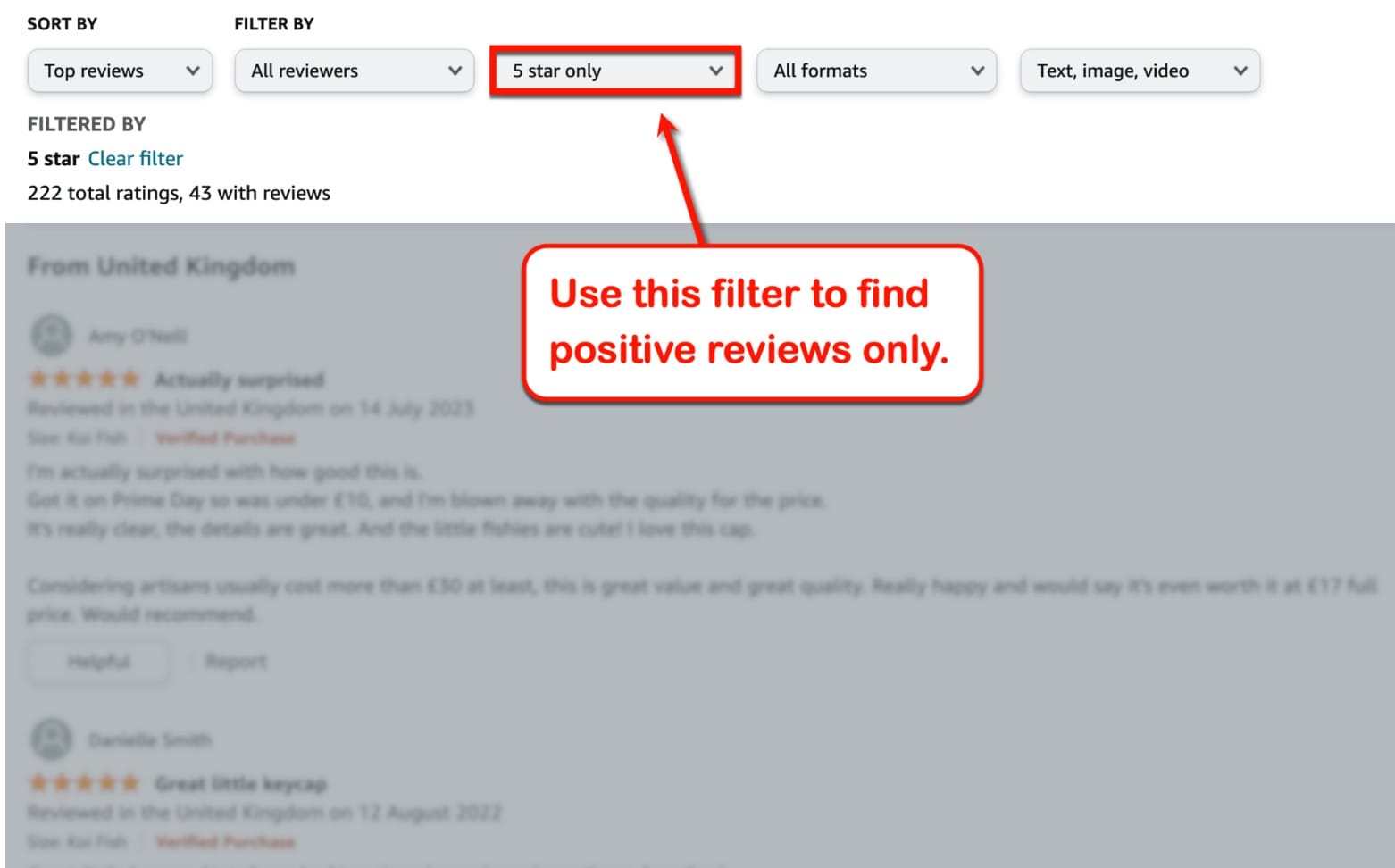
Remember, filter controls are different for every website. But wherever there are reviews, there are usually filters that you can use to sieve through tonnes of customer feedback.
The fun starts right after filtering the reviews.
You should immediately be able to spot positive things you can add to your spreadsheet.
For example, in the review below, the terms "quality for the price," "great value," "great quality," "clear," and "details" really drive home the point.
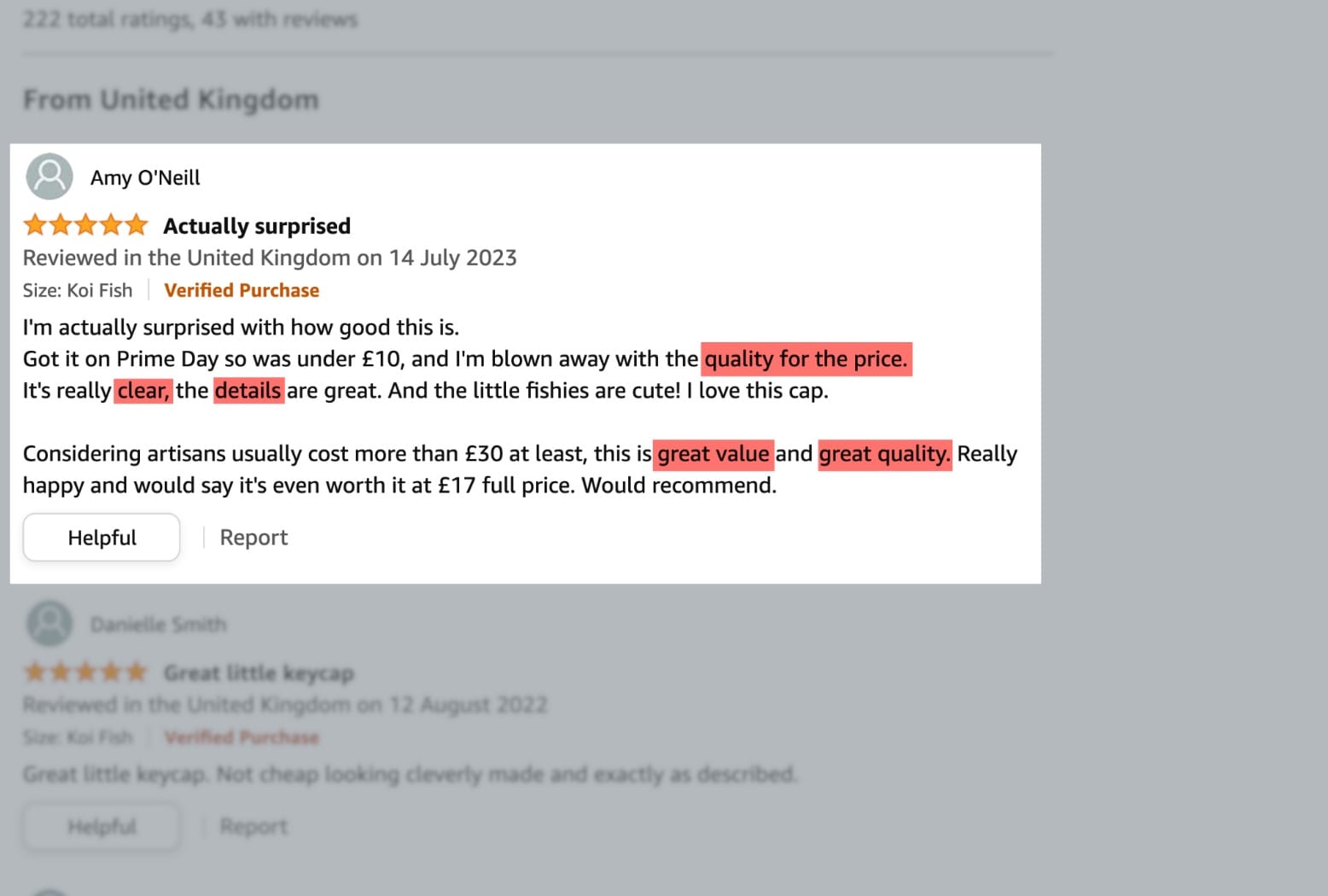
These terms would make fine additions to your product copywriting spreadsheet/sentiment analysis documents.
Just don't stop at one review. Keep looking through them for positive reviews to build up a nice, diversified selection of words to enhance your product descriptions.
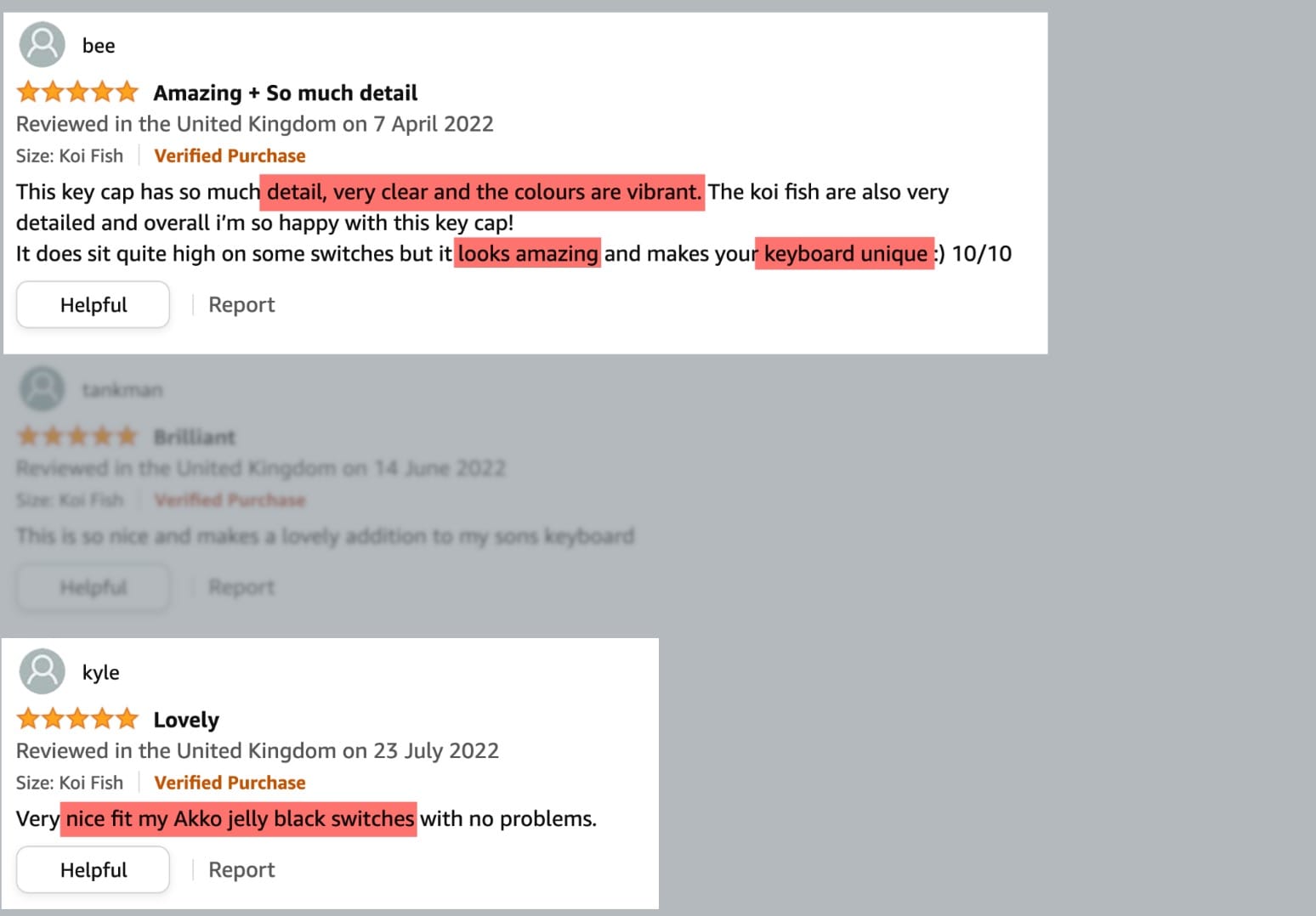
Don't forget to copy and paste these terms into your spreadsheet — you'll need them later.
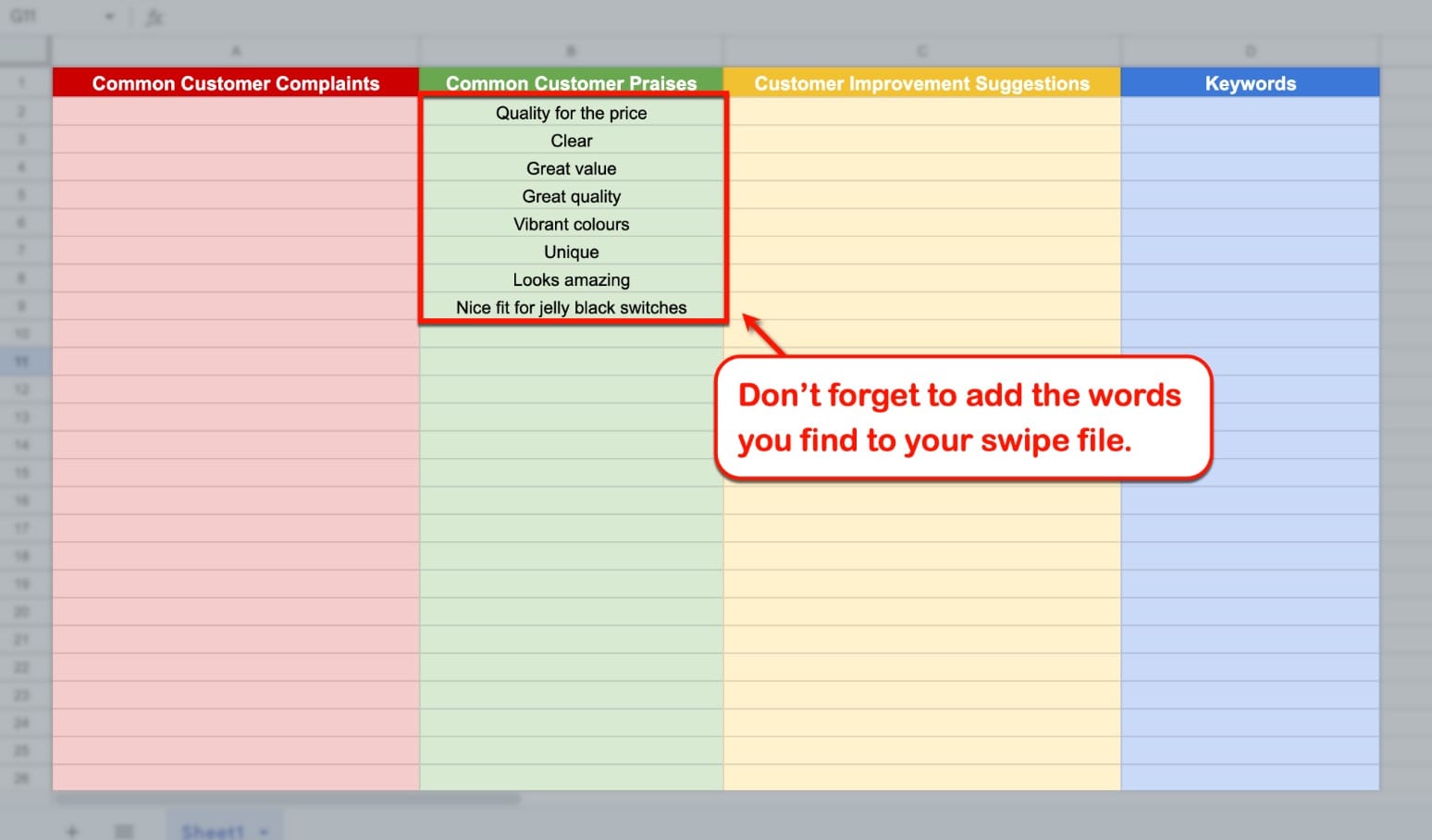
Step 4: Scan negative reviews to identify customer pain points
When it comes to competitor analysis, negative reviews are just as important as positive ones.
Fortunately, most eCommerce websites and review platforms also let you filter out negative reviews with just a few clicks.
Anything below three stars is guaranteed to have at least one complaint, leading to more words in your spreadsheet.
Of course, you can also filter out one-star reviews to scrape the bottom of the barrel. Those are guaranteed to mention touchy issues that are worth addressing in your product descriptions.
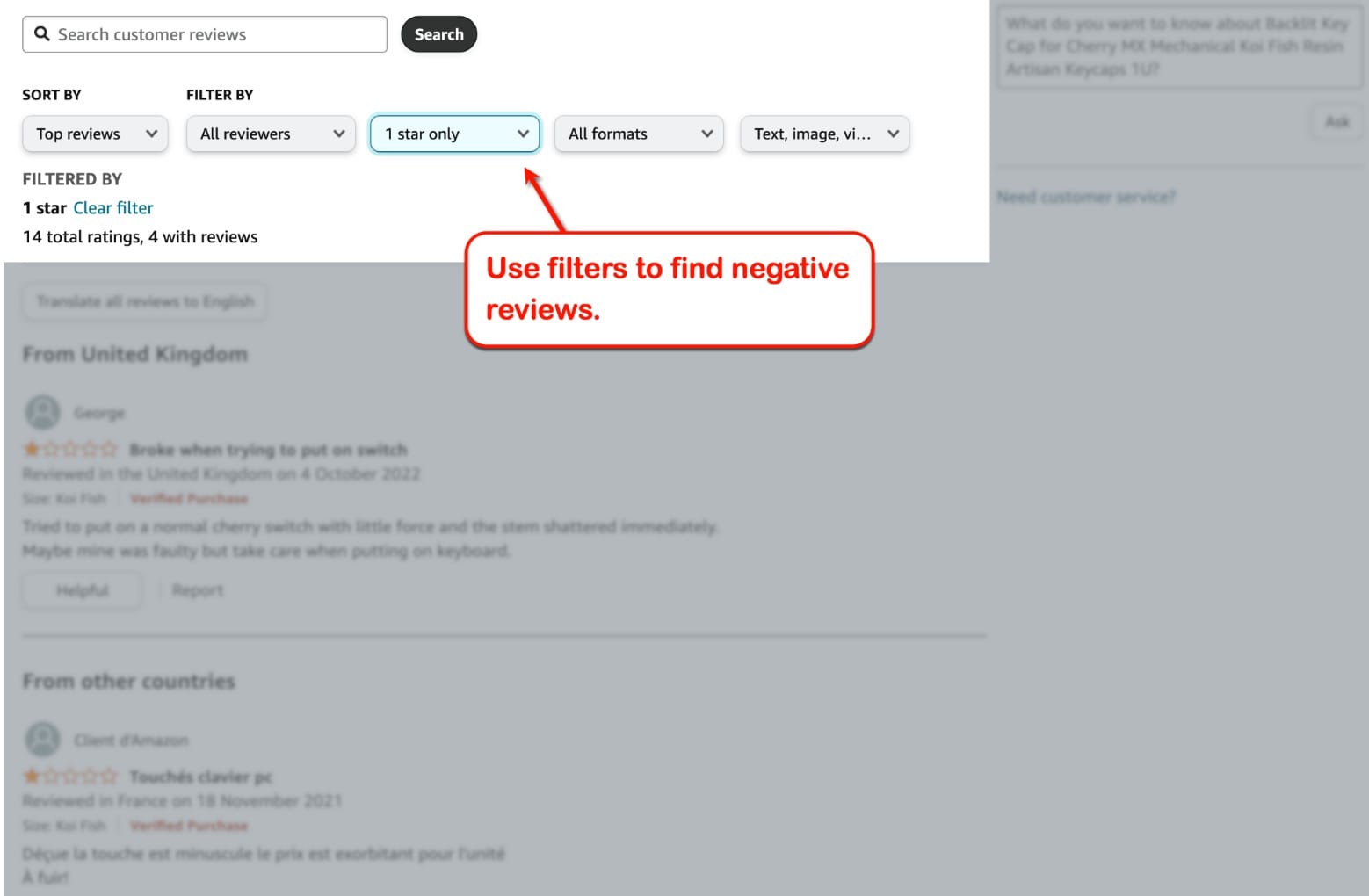
Here's an example of a negative customer review on Amazon:
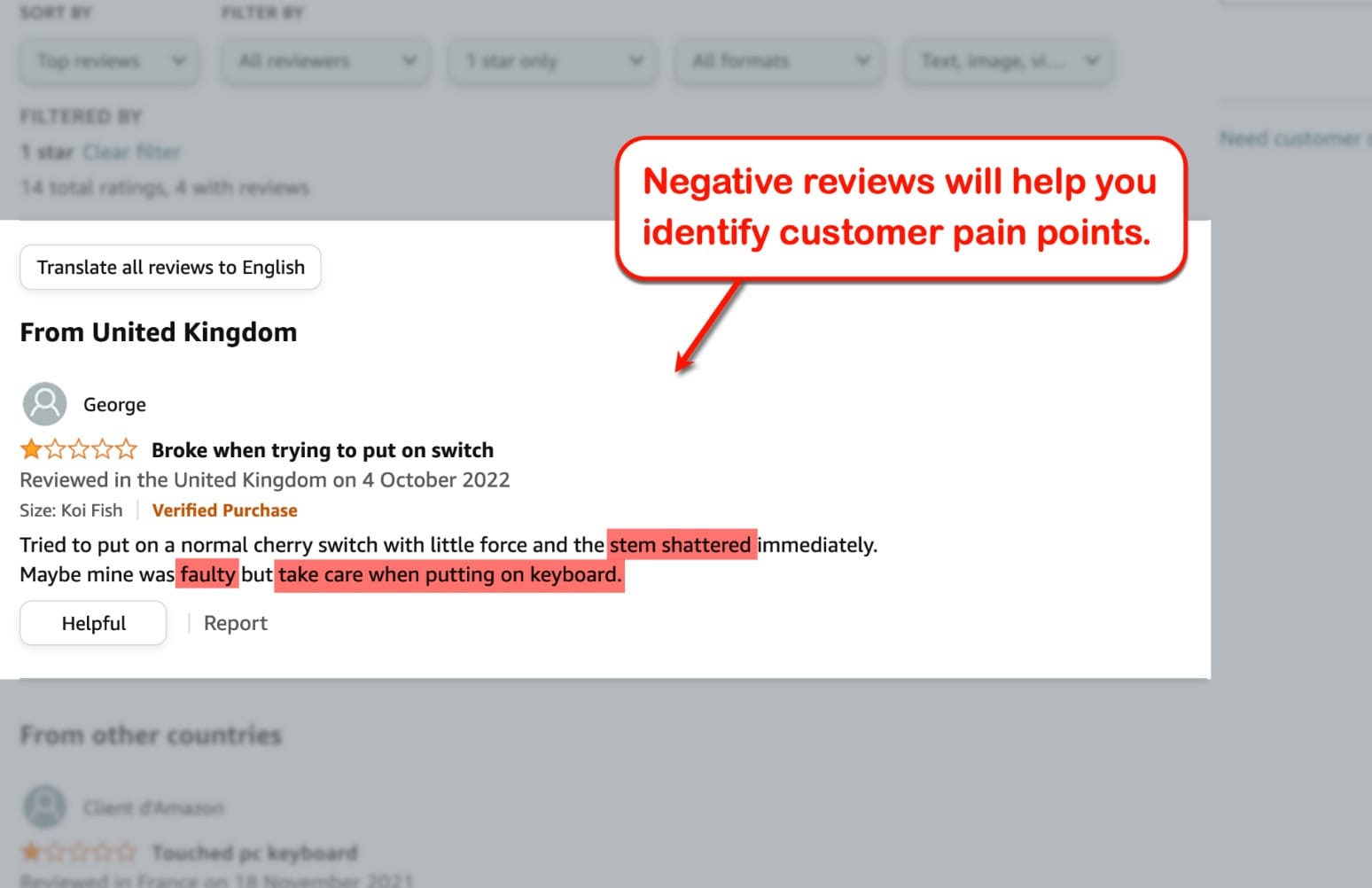
When analysing negative reviews, don't just take keywords at face value. Pay close attention to what customers are saying and keep notes in your spreadsheet.
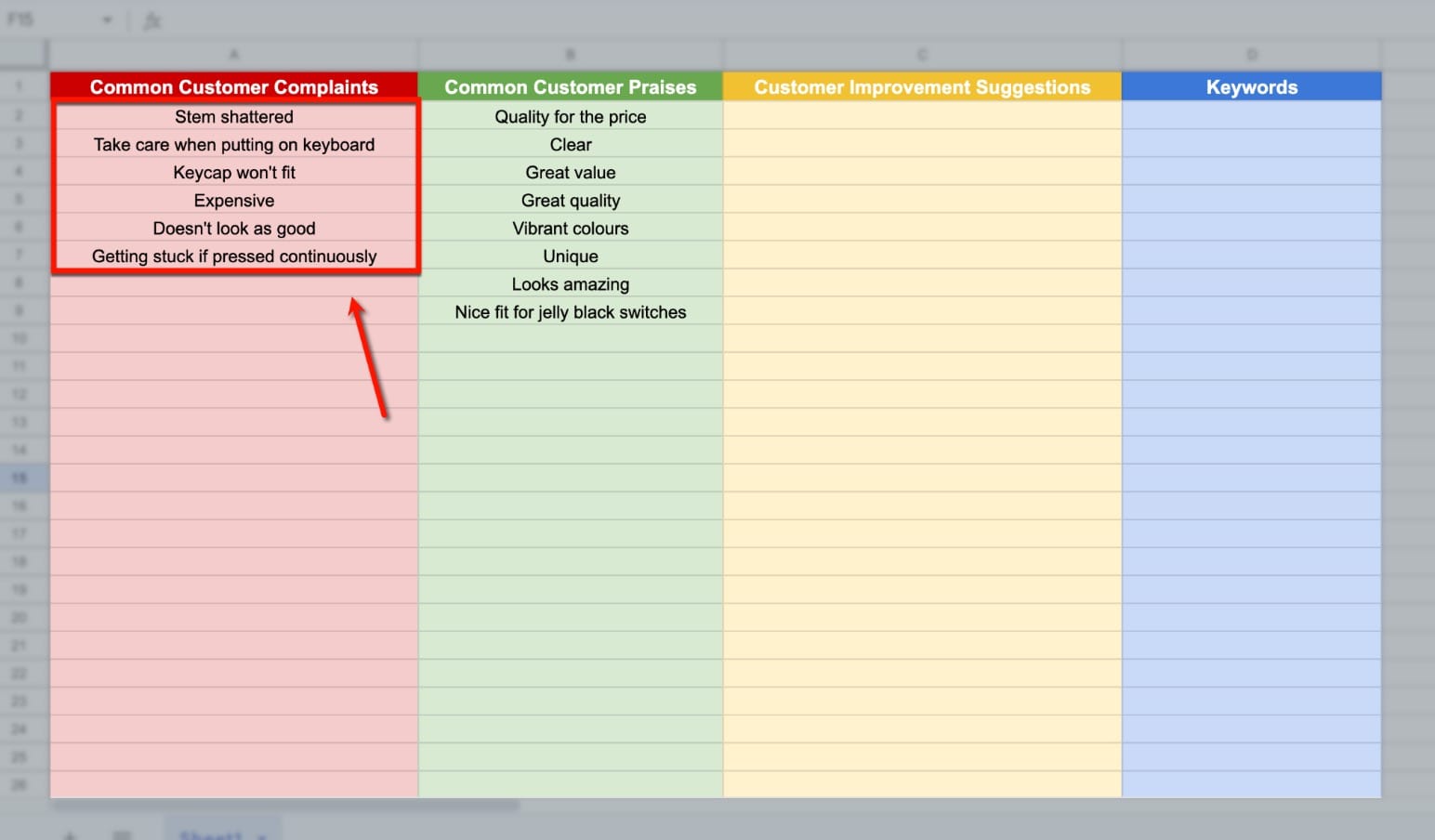
Step 5: Look for customer suggestions
While reading negative and positive reviews, you might stumble on a few improvement requests from customers.
Even customers who write stellar reviews may chip in suggestions.
For example, here's a customer review on Amazon hoping for the seller to offer more colour variations:
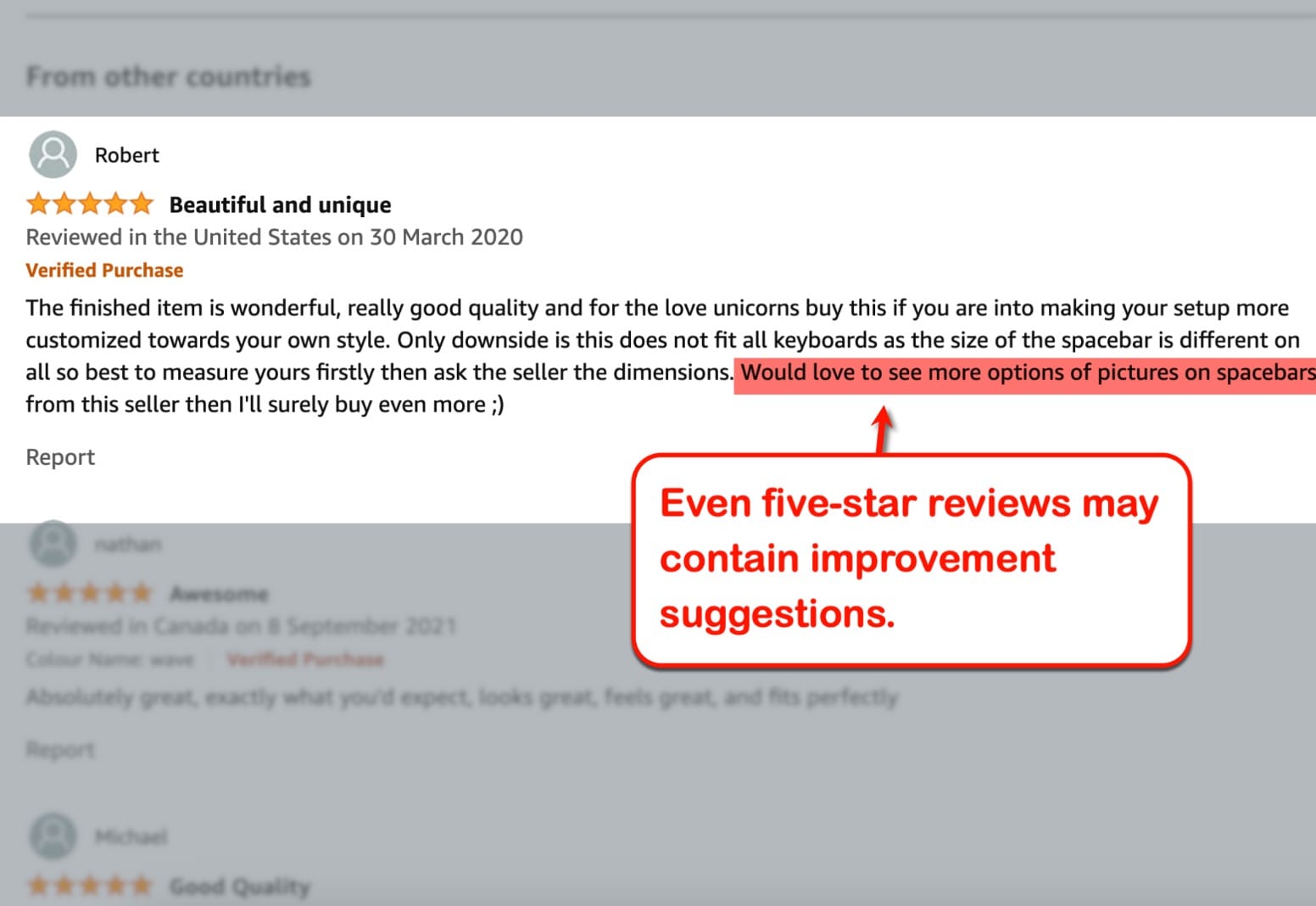
Customers might not say it outright, but whenever they mention anything they didn't like about the product, you can also consider their feedback as suggestions.
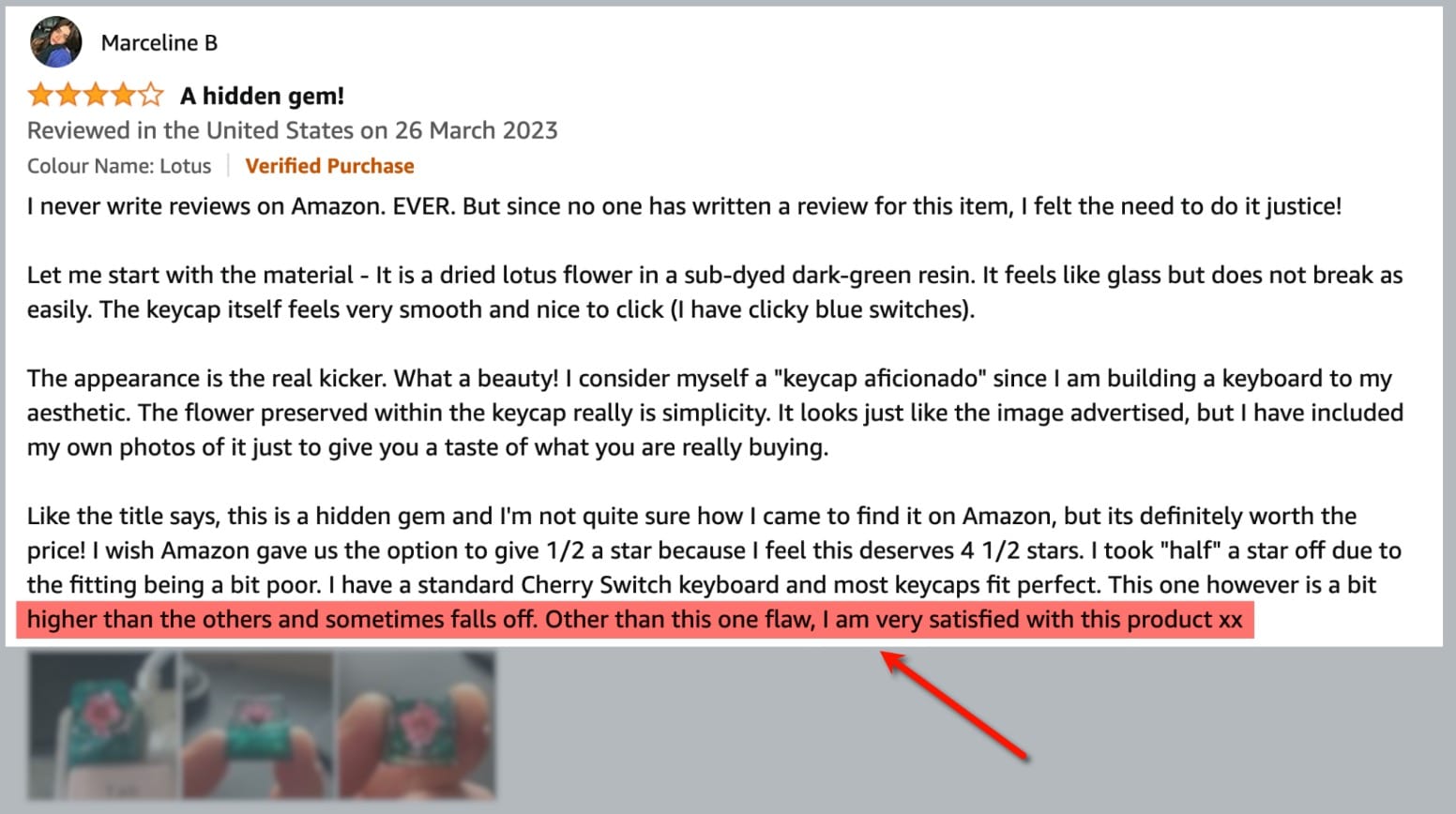
If your products can accommodate these requests, mention them in your product descriptions to establish your competitive advantage.
For now, track them in your spreadsheet to guide the content creation process.
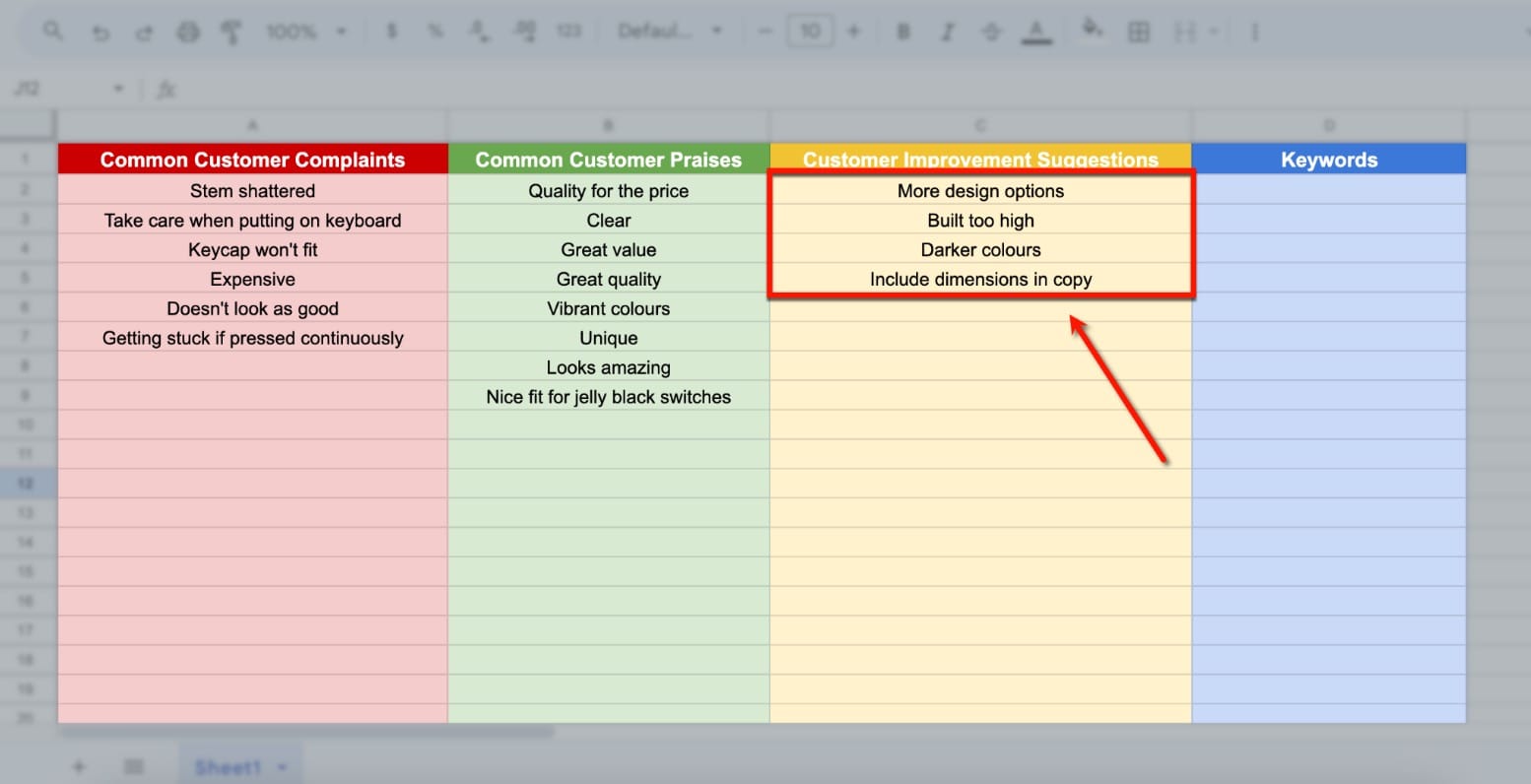
Step 6: Find keywords to target
At this point, you should have more than enough ideas to create killer product descriptions.
Now, you can start concentrating on the SEO.
You may come across distinguishable SEO keywords in product page reviews purely by chance. Just look for commonly repeated terms that customers use when describing the product experience.
In relation to the examples above, some of the keywords that popped up are:
- "Quality keycaps"
- "OEM profile"
- "Artisan keycaps"
- "Backlit keycaps"
- "PBT keycaps"
- "Cherry MX switches"
- "BOX White switches"
If you don't recognise any noticeable keywords in product page reviews, consider looking at standalone reviews in blogs.
Google should lead you right to them.
Just enter a keyword along with your competitor's brand and the term "review" to find the information you need.
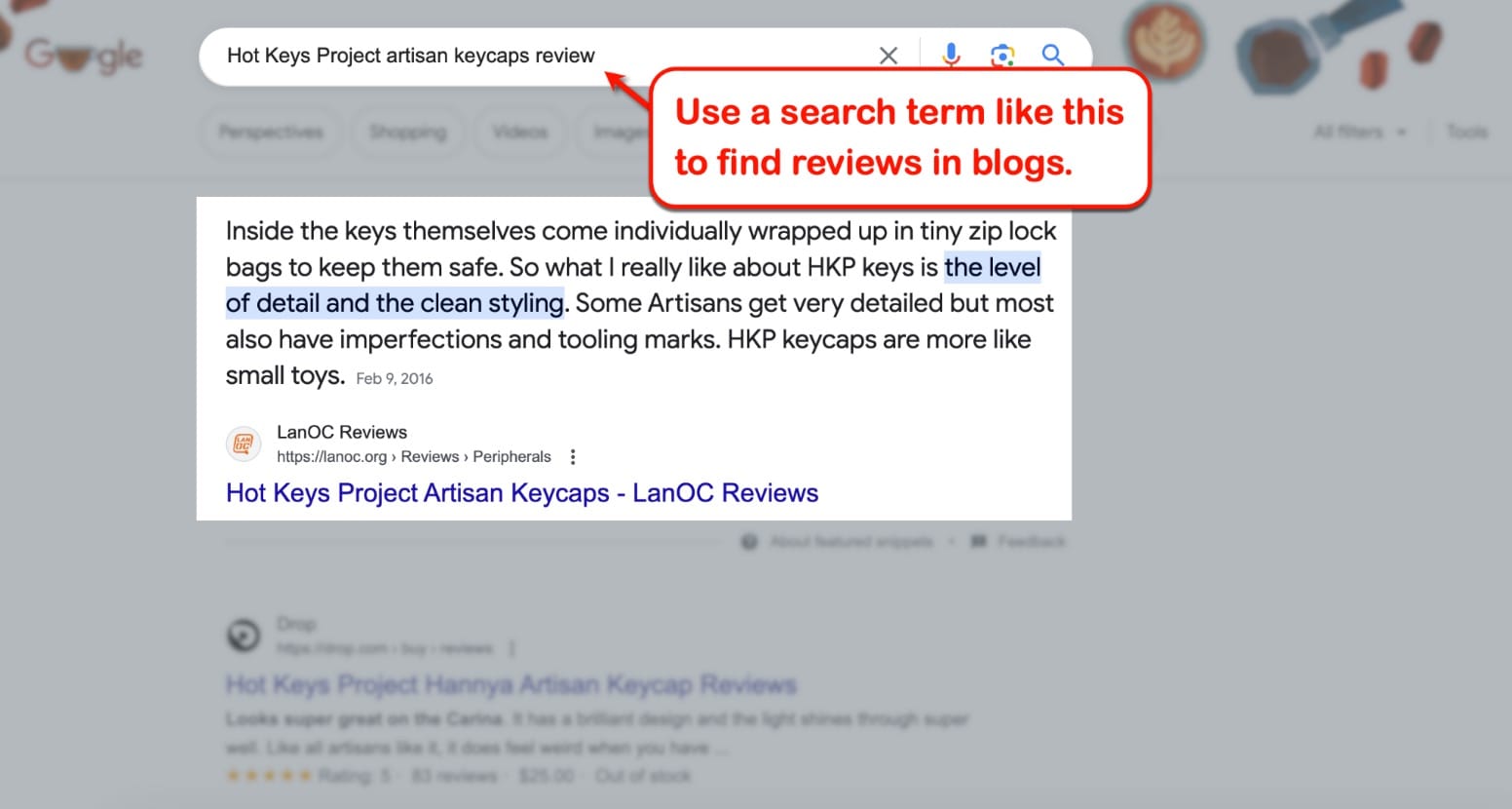
When you find them, fire up your favourite SEO tool — be it Ubersuggest, Ahrefs, or Semrush — and head to their keyword analysis or organic research tool.
For example, the Organic Research tool in Semrush can reveal page-level keywords. Place the review's URL into the domain field and let the tool work its magic.
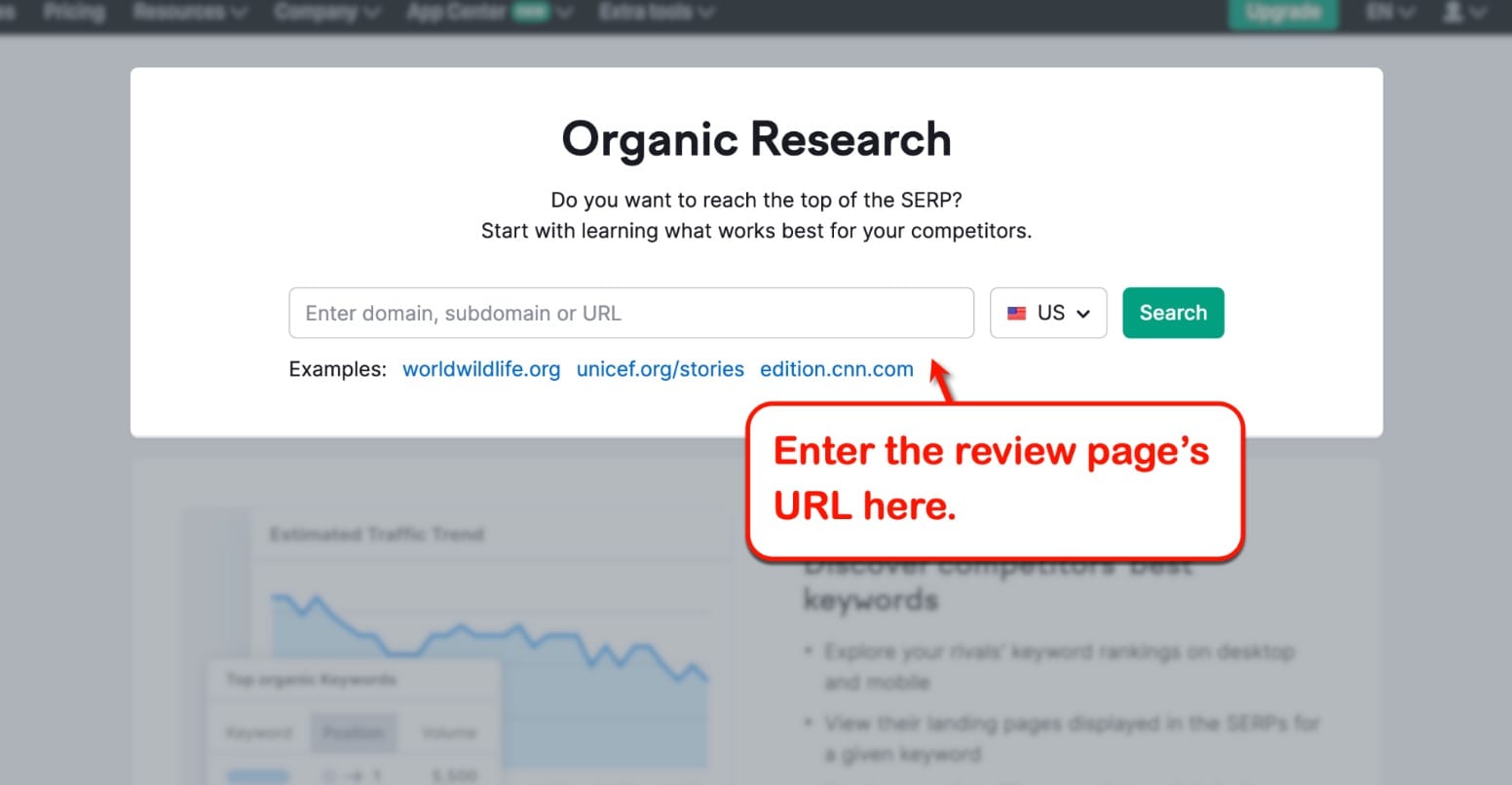
After several seconds, your organic research report should be ready.
The review article's keywords are in the "Top Keywords" and "Top Position Changes in Organic" sections. Add them to your spreadsheet, and you're ready for the next step.
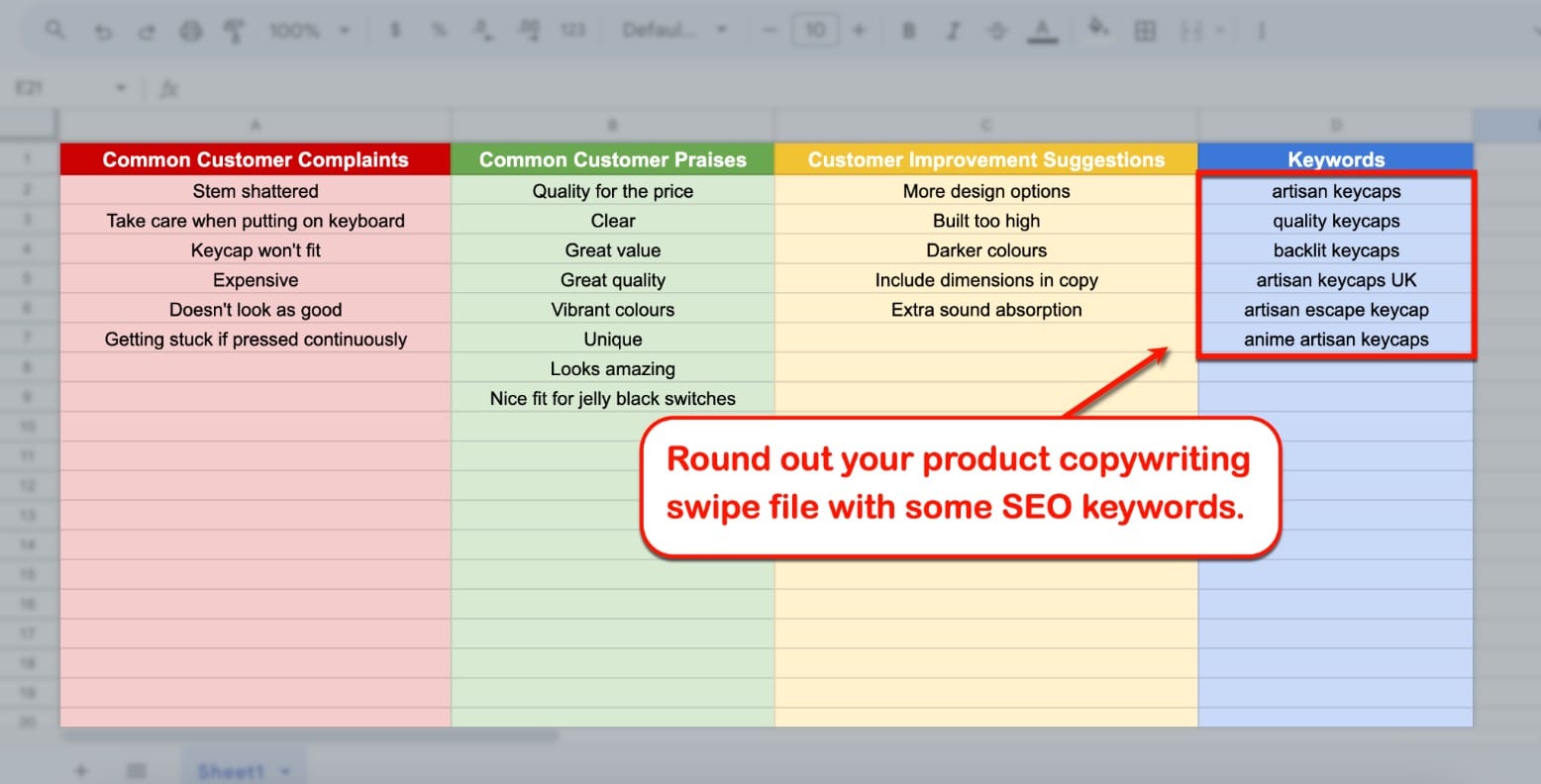
Need more keywords?
Take the review article's top keyword and run it through a keyword research tool. This will help you discover more related keywords and relevant questions you can mention in product descriptions.
Step 7: Track social media mentions and online communities
Not everyone is willing to go back to a store page for the sake of leaving reviews.
In fact, many internet customers like to share recommendations (or vent their frustrations) on social media.
They don't even need to post actual reviews. In most cases, their comments or responses to threads contain a lot of keywords you can use in your product descriptions.
For example, here are a couple of useful replies on Reddit:
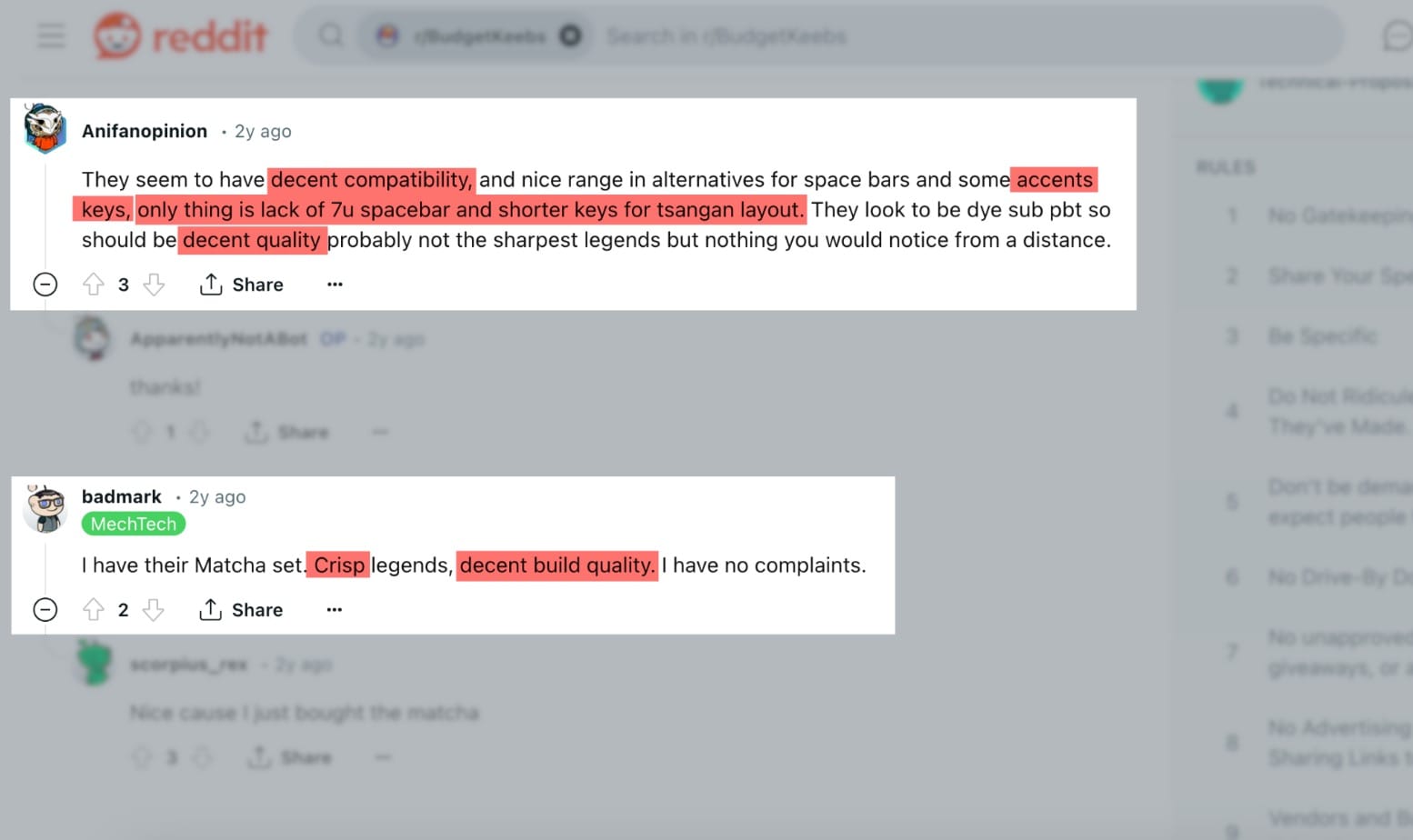
When you find them, go ahead and add those terms to your spreadsheet. They could fit under any sentiment (praise, complaint, or suggestion) or SEO keyword category.
If you're having trouble looking for customer feedback on social media, use social media listening or keyword monitoring tools. These will help you spot mentions of your competitors' products wherever they're posted.
Step 8: Writing product descriptions
Right now, your analysis file should look something like this:
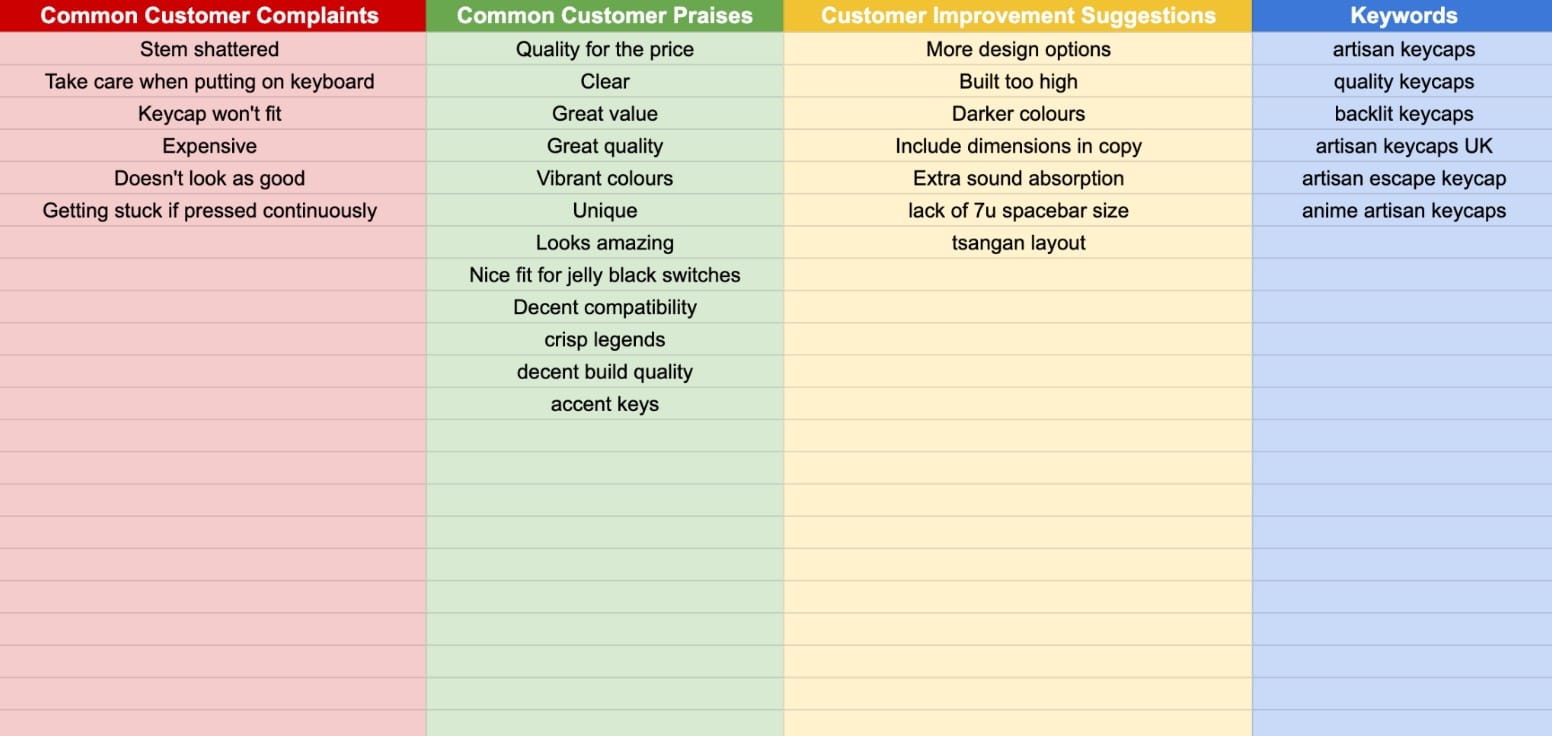
Take note, we've only been at it for several minutes. Imagine how many words you can collect if you invest an hour into your competitor analysis.
All that's left is writing your product descriptions.
Here are crucial things to remember:
- Address customer complaints. Talk about the common complaints customers have with your competitors' products. Reassure that they can expect a better experience when buying from you.
- Highlight sought-after qualities. Make desirable product qualities easy to find and detailed. Put them above the fold or use formatting techniques like bullet points to highlight them.
- Include a section for requested features. Let your customers know if your products offer highly-requested features that are missing from competitors. Depending on the feature, it can be a main talking point in your product descriptions or a special mention below the main copy.
- Weave in SEO keywords to boost search engine visibility. Use content optimisation tools like Surfer to get actionable suggestions on improving product descriptions. This is extremely important if you're building dedicated product pages on your website.
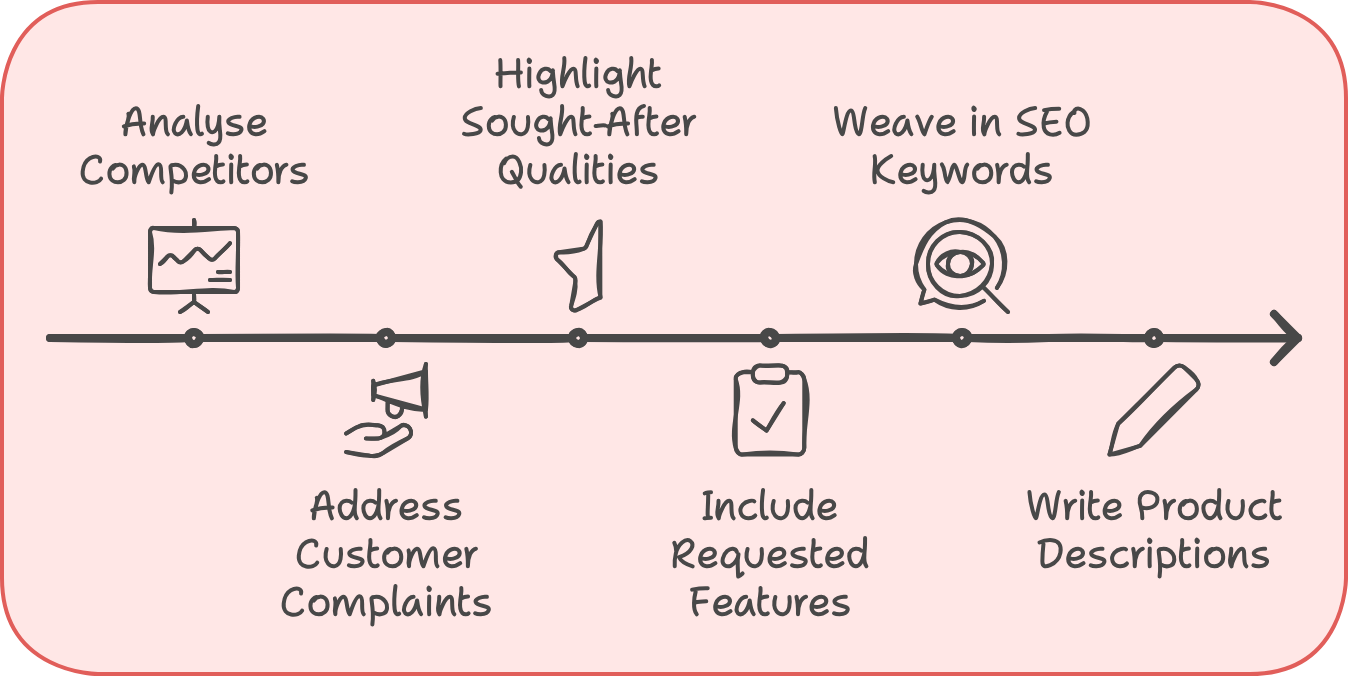
To give you an idea, here's what a good product description would look like using the keywords in our list:
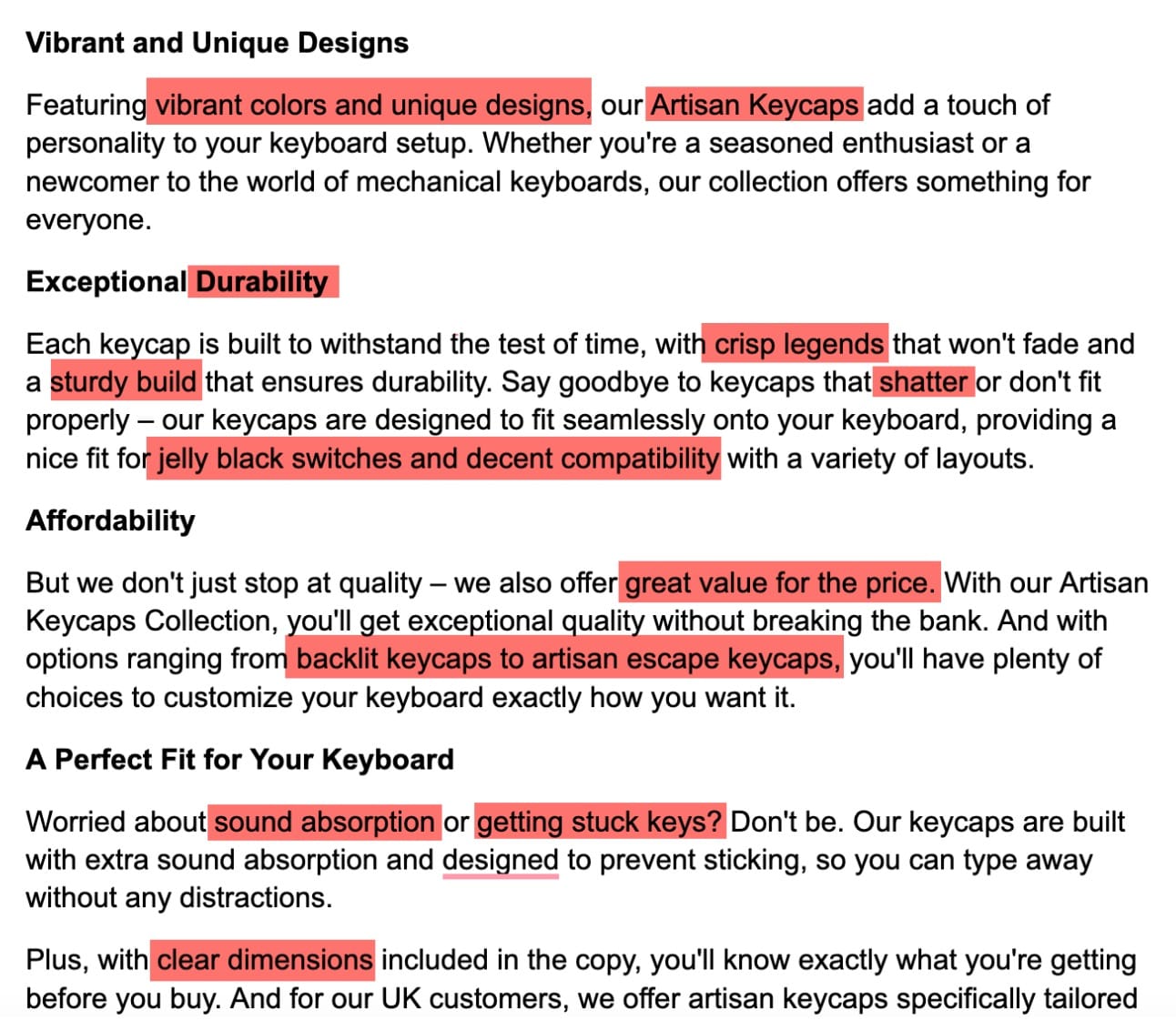
Let experts handle your product copywriting
Conducting competitor analysis is one thing.
Incorporating competitor keywords and customer feedback into your copywriting, however, is an entirely different beast.
Perhaps the biggest challenge is naturally weaving in keywords without disrupting the readability and flow of your product descriptions. For that, you'll need skilled professionals who understand your content needs.
If you're struggling, my team is more than happy to help.
Contact me here and let's discuss your challenges.






